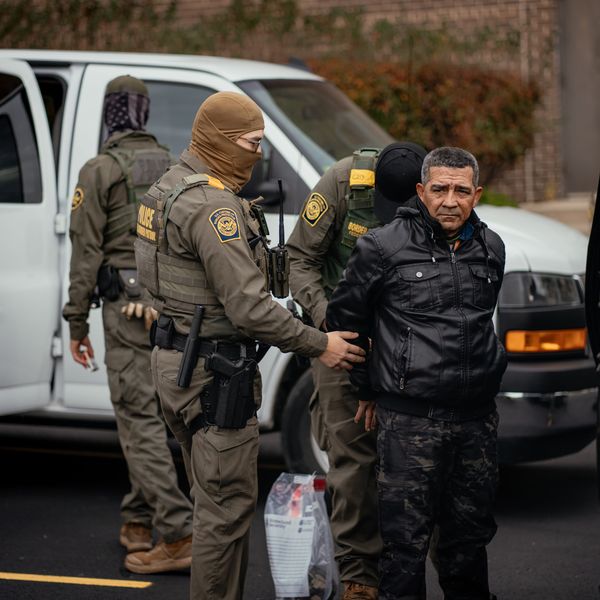Immigrant Deaths Covered Up
Monday, January 11, marks eight years since the Bush administration
transferred the first prisoners to the U.S. detention facility at
Guantanamo Bay. Ever since, human rights groups have pushed for the
closure of Guantanamo and they're pushing harder now for the Obama
administration to implement its plans to transfer or release detainees
and shut the place.
Monday, January 11, marks eight years since the Bush administration
transferred the first prisoners to the U.S. detention facility at
Guantanamo Bay. Ever since, human rights groups have pushed for the
closure of Guantanamo and they're pushing harder now for the Obama
administration to implement its plans to transfer or release detainees
and shut the place.
Close Guantanamo and we'll restore the rule of law and American
standing in the world, some human rights advocates say. Unfortunately,
it won't be that easy. Prolonged detention in criminal conditions is
not only happening in Gitmo. It's happening in our immigration system.
In a series of investigations, New York Times reporter Nina Bernstein has been digging for facts since she broke a story back in April about a Pakistani man who died in immigration detention and then vanished from DHS's records.
There have been, it turns out, at least 107 deaths in detention
since the creation of Immigration and Customs Enforcement (ICE) agency
in late 2003. And now new FOIA documents reveal widespread wrongdoing
and extensive cover-ups.
Even 107 deaths is an underestimate. According to the story, ICE
tries to ship dying detainees home to lower fatality rates - and
escape scrutiny -- and medical bills. They called it humanitarian
release. Talk about ICE and cold.
In at least one case authorities left a man in a coma untreated in
his cell for over 13 hours while they tried to persuade his cousins to
take responsibility for his care. When Boubacar Bah, 52, died, the
local ICE field director recommended flying his body to Guinea to
prevent his widow from showing up for a funeral and attracting news
coverage.
The high rate of death hidden by a successful culture of secrecy
can in large part be blamed on "what some of the agency's own employees
say is a central flaw," namely allowing ICE to regulate and investigate
itself. That's quite some flaw. Some Bush administration era officials
who played a role in the coverups remain in top posts under Obama. Will
Bernstein's reporting stir Congress to act? Only if there's pressure.
Bernstein's reporting is exactly the kind of in depth work newspaper
owners claim is endangered in the new economy. Now let's see if it's
picked up. Immigration detention centers exist all over the
country. Which local reporters are going to dig into this where they
are? Let's hope it doesn't take eight years.
An Urgent Message From Our Co-Founder
Dear Common Dreams reader, The U.S. is on a fast track to authoritarianism like nothing I've ever seen. Meanwhile, corporate news outlets are utterly capitulating to Trump, twisting their coverage to avoid drawing his ire while lining up to stuff cash in his pockets. That's why I believe that Common Dreams is doing the best and most consequential reporting that we've ever done. Our small but mighty team is a progressive reporting powerhouse, covering the news every day that the corporate media never will. Our mission has always been simple: To inform. To inspire. And to ignite change for the common good. Now here's the key piece that I want all our readers to understand: None of this would be possible without your financial support. That's not just some fundraising cliche. It's the absolute and literal truth. We don't accept corporate advertising and never will. We don't have a paywall because we don't think people should be blocked from critical news based on their ability to pay. Everything we do is funded by the donations of readers like you. Will you donate now to help power the nonprofit, independent reporting of Common Dreams? Thank you for being a vital member of our community. Together, we can keep independent journalism alive when it’s needed most. - Craig Brown, Co-founder |
Monday, January 11, marks eight years since the Bush administration
transferred the first prisoners to the U.S. detention facility at
Guantanamo Bay. Ever since, human rights groups have pushed for the
closure of Guantanamo and they're pushing harder now for the Obama
administration to implement its plans to transfer or release detainees
and shut the place.
Close Guantanamo and we'll restore the rule of law and American
standing in the world, some human rights advocates say. Unfortunately,
it won't be that easy. Prolonged detention in criminal conditions is
not only happening in Gitmo. It's happening in our immigration system.
In a series of investigations, New York Times reporter Nina Bernstein has been digging for facts since she broke a story back in April about a Pakistani man who died in immigration detention and then vanished from DHS's records.
There have been, it turns out, at least 107 deaths in detention
since the creation of Immigration and Customs Enforcement (ICE) agency
in late 2003. And now new FOIA documents reveal widespread wrongdoing
and extensive cover-ups.
Even 107 deaths is an underestimate. According to the story, ICE
tries to ship dying detainees home to lower fatality rates - and
escape scrutiny -- and medical bills. They called it humanitarian
release. Talk about ICE and cold.
In at least one case authorities left a man in a coma untreated in
his cell for over 13 hours while they tried to persuade his cousins to
take responsibility for his care. When Boubacar Bah, 52, died, the
local ICE field director recommended flying his body to Guinea to
prevent his widow from showing up for a funeral and attracting news
coverage.
The high rate of death hidden by a successful culture of secrecy
can in large part be blamed on "what some of the agency's own employees
say is a central flaw," namely allowing ICE to regulate and investigate
itself. That's quite some flaw. Some Bush administration era officials
who played a role in the coverups remain in top posts under Obama. Will
Bernstein's reporting stir Congress to act? Only if there's pressure.
Bernstein's reporting is exactly the kind of in depth work newspaper
owners claim is endangered in the new economy. Now let's see if it's
picked up. Immigration detention centers exist all over the
country. Which local reporters are going to dig into this where they
are? Let's hope it doesn't take eight years.
Monday, January 11, marks eight years since the Bush administration
transferred the first prisoners to the U.S. detention facility at
Guantanamo Bay. Ever since, human rights groups have pushed for the
closure of Guantanamo and they're pushing harder now for the Obama
administration to implement its plans to transfer or release detainees
and shut the place.
Close Guantanamo and we'll restore the rule of law and American
standing in the world, some human rights advocates say. Unfortunately,
it won't be that easy. Prolonged detention in criminal conditions is
not only happening in Gitmo. It's happening in our immigration system.
In a series of investigations, New York Times reporter Nina Bernstein has been digging for facts since she broke a story back in April about a Pakistani man who died in immigration detention and then vanished from DHS's records.
There have been, it turns out, at least 107 deaths in detention
since the creation of Immigration and Customs Enforcement (ICE) agency
in late 2003. And now new FOIA documents reveal widespread wrongdoing
and extensive cover-ups.
Even 107 deaths is an underestimate. According to the story, ICE
tries to ship dying detainees home to lower fatality rates - and
escape scrutiny -- and medical bills. They called it humanitarian
release. Talk about ICE and cold.
In at least one case authorities left a man in a coma untreated in
his cell for over 13 hours while they tried to persuade his cousins to
take responsibility for his care. When Boubacar Bah, 52, died, the
local ICE field director recommended flying his body to Guinea to
prevent his widow from showing up for a funeral and attracting news
coverage.
The high rate of death hidden by a successful culture of secrecy
can in large part be blamed on "what some of the agency's own employees
say is a central flaw," namely allowing ICE to regulate and investigate
itself. That's quite some flaw. Some Bush administration era officials
who played a role in the coverups remain in top posts under Obama. Will
Bernstein's reporting stir Congress to act? Only if there's pressure.
Bernstein's reporting is exactly the kind of in depth work newspaper
owners claim is endangered in the new economy. Now let's see if it's
picked up. Immigration detention centers exist all over the
country. Which local reporters are going to dig into this where they
are? Let's hope it doesn't take eight years.

